| |
|
|
FAMILIAR BLUET
Enallagma
civile
|
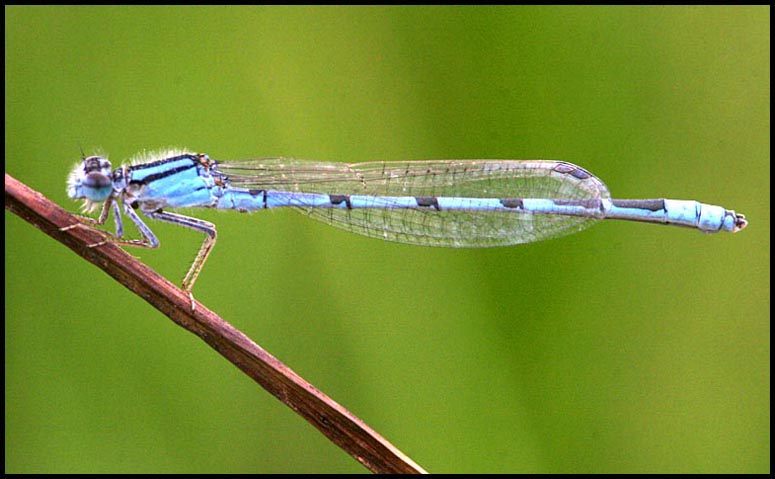
Familiar Bluet is a tiny damselfly that is common and widespread. Males
(above) are light blue with black bands and stripes. Familiar Bluet is
among the bluets that have a lot more blue than black, particularly on
the 3rd abdominal segment, which helps to separate it from another very
common bluet, Tule Bluet.
photo (above) 1
Oct 2006 Carmel River mouth
MTY
|
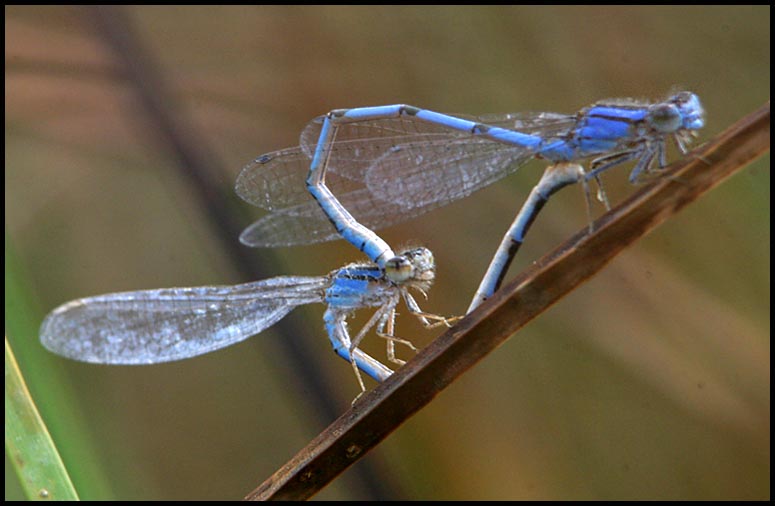
Female bluets are quite variable. The one "in wheel" (above) is almost
as blue as the male but note that she has a lot more black on the
upperside
of her abdomen. Other females can be olive, tan or whitish instead of
blue.
The one below, for example, is washed with turquoise and olive. Female
bluets are exceedingly similar to each other and while we can identify
the one above, because it is mating with a male Familiar, the one below
is only assumed to be a Familiar because there were males of that
species
nearby. However, both Familiar and Tule Bluets occur together, and
occasionally
interbreed (T. Manolis, in litt.), so the identity of females is really
hypothetical only.
photo (above) 25
Sep 2006 Salinas River
mouth
photo (below) 25 July 2006 near
Salinas
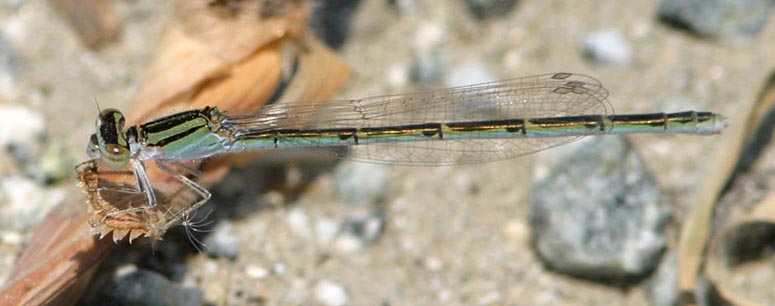
|
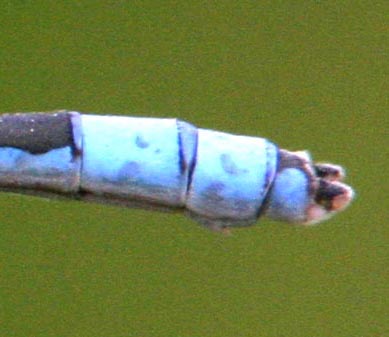 Male
Familiar Bluets are identified by the large fin-shaped upper appendages
(cerci) that extend well beyond the lower appendages (paraprocts), and
the two combined (left) give a long triangular shape to the abdominal
tip.
This shape can often be seen with binoculars and helps eliminate a
suite
of other bluets in which the paraprocts are longer than the cerci
(e.g.,
Northern Bluet). Note also the distinctive pale lobe in the middle of
the
trailing edge of the dark cerci. Tule Bluet has a caruncle at the tip
of
its cerci that can be rather similar, but it tends to be at the upper
tip
of the upper appendage, not so much in the middle. Hybrids between
Familiar
and Tule Bluets are known, complicating the issue (Manolis 2003). Male
Familiar Bluets are identified by the large fin-shaped upper appendages
(cerci) that extend well beyond the lower appendages (paraprocts), and
the two combined (left) give a long triangular shape to the abdominal
tip.
This shape can often be seen with binoculars and helps eliminate a
suite
of other bluets in which the paraprocts are longer than the cerci
(e.g.,
Northern Bluet). Note also the distinctive pale lobe in the middle of
the
trailing edge of the dark cerci. Tule Bluet has a caruncle at the tip
of
its cerci that can be rather similar, but it tends to be at the upper
tip
of the upper appendage, not so much in the middle. Hybrids between
Familiar
and Tule Bluets are known, complicating the issue (Manolis 2003).
photo (left) 1 Oct 2006
Carmel River mouth
photo (below) 25 Sep 2006
Salinas River mouth
Immature males
further complicate the picture.
The areas that will be pale blue on mature males can be tinged olive
(like
the one below) or lavender-gray (Manolis 2003). In addition, the colors
of any individual may change with temperature and age.
|
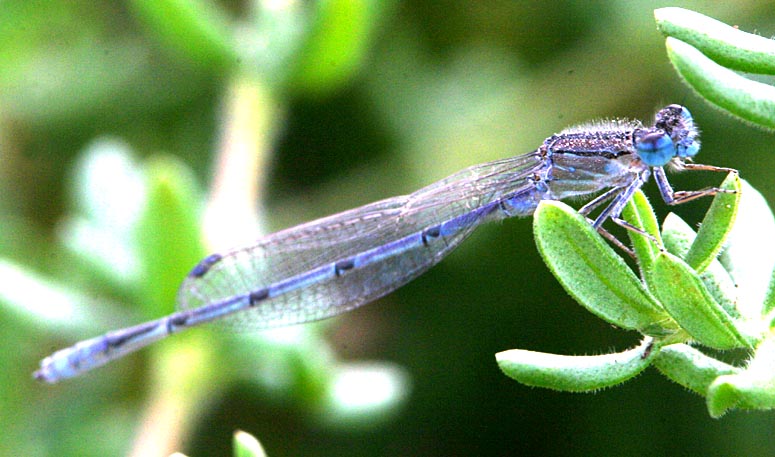
|
|
|
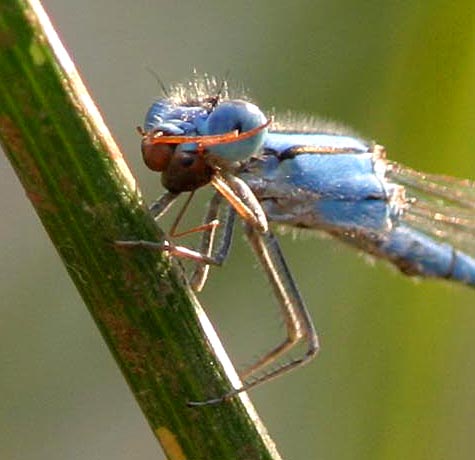 Familiar
Bluets oviposit in tandem (above), with the female depositing eggs
below
the surface of a quiet backwater while the male hovers overhead,
holding
her by the back of the "neck." Familiar
Bluets oviposit in tandem (above), with the female depositing eggs
below
the surface of a quiet backwater while the male hovers overhead,
holding
her by the back of the "neck."
When not engaged in reproductive behavior, flying
Familiar Bluets, like
all odonates, are voracious predators. This male (right) is
dismembering
and eating what looks like a small ant.
Familiar Bluets (like other bluets) are only about
1.5 inches long.
Thus all the photos of this page are shown much larger than life size.
It can be most interesting to view them close-up through a hand lens or
the macro lens of a camera. Fortunately, this species is very common
and
widespread in California, and in Monterey County, and opportunities to
observe them abound.
Photo (above) 23 July 2006 near
Salinas
Photo (right) 29 July 2006 Pinnacles
NM, San Benito Co.
|
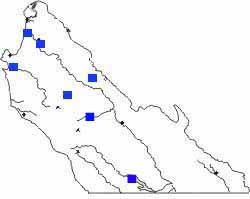 This
map shows only some areas where Familiar Bluet has been found. It
probably
occurs everywhere in the MTY lowlands where there are open marshes,
drainage
ditches, and quiet backwaters. However, it has not yet been observed
higher
into the foothills or along more shaded creeks of the Santa Lucia
Range,
where other bluets (e.g., Arroyo and Northern) seem to be more common.
Familiar Bluets do, however, range well up into the Diablo Range and
can
be common in Pinnacles National Monument, San Benito Co. This
map shows only some areas where Familiar Bluet has been found. It
probably
occurs everywhere in the MTY lowlands where there are open marshes,
drainage
ditches, and quiet backwaters. However, it has not yet been observed
higher
into the foothills or along more shaded creeks of the Santa Lucia
Range,
where other bluets (e.g., Arroyo and Northern) seem to be more common.
Familiar Bluets do, however, range well up into the Diablo Range and
can
be common in Pinnacles National Monument, San Benito Co.
MTY specimens of Familiar Bluet date back to
1942 (Hastings NHR) but
their flight season in the county has not been fully documented. Data
on
files document records between 5 May-28 October, but elsewhere in
California
the flight season extends from March to early December (Manolis 2003).
|
|
|
Literature cited:
- Manolis, T. 2003. Dragonflies and Damselflies of
California. Univ. of
Calif.
Press, Berkeley.
Web resources:
Major identification web sites with much information on California
odes include:
For sites with excellent photos to compare for identification or to
simply
enjoy, see:
Many of these sites have links to other useful pages. Kathy Biggs's
site
is particularly useful in her selection of links. |
|
All photos © Don Roberson 2007
TOP
|
|
|
Page created 2-5 Oct 2006,
revised 16 May 2007
|
|
|
|
|
